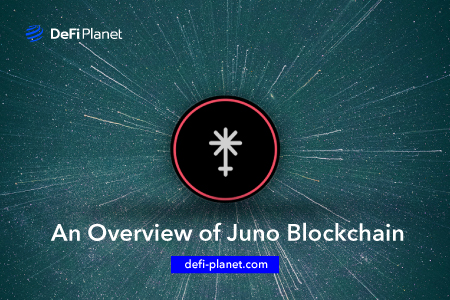The Juno blockchain is one of the newer generations of blockchains created to solve the blockchain trilemma: scalability, security, and decentralization. There is hardly any blockchain that has successfully achieved all three.
The Ethereum network, for example, is decentralized and secure but lacks scalability. On the Ethereum chain, users can conduct transactions with little or no fear of being hacked.
Crypto enthusiasts can become miners on the Ethereum 1.0 Proof-of-Work (PoW) network or potential validators on the Ethereum 2.0 or Serenity Proof-of-Stake (PoS) network. Currently, the network lacks a scalable solution. Congestion reigns supreme in the first version of the Ethereum network, and transaction fees are outrageously high.
The Juno blockchain is one of the newer generations of blockchain technology that promises to solve the blockchain trilemma, particularly in terms of scalability.
This article explores the Juno blockchain, comprehensively examining its architecture and native token.
Who created the Juno blockchain?
Juno is a community-centric blockchain developed by some active participants in the Cosmos ecosystem. The Cosmos sister hub was built as a collaborative effort by members such as delegators, developers, and validators on Cosmos.
According to the Juno documentation, some of the primary contributors on the network are Andrea Di Michele-Dimi (stakefish), Wolfcontract (SG-1), Blockcreators, Jake Hartnell (Stargaze.Zone), and Jack Zampolin (Strangelove Ventures).
What is Juno blockchain?
Juno is a Layer-1 blockchain built using the Cosmos SDK and utilizes the Proof-of-Stake consensus mechanism. Its smart contract functionalities allow developers to build decentralized apps, ranging from NFT platforms to DeFi ecosystems on the blockchain.
The network is highly interoperable with other blockchains, allowing it to possess cross-chain functionalities, and this is because it incorporates the Inter Blockchain Communication (IBC) protocol into its architecture.
On the Juno blockchain, smart contracts are launched using the Rust and Go programming languages.
What is the architecture of the Juno blockchain?
Juno, a Proof-of-Stake network built on Cosmos, incorporates elements available in the Cosmos blockchain.
• CosmWasm
Juno, a Cosmos-based smart contract-enabled blockchain, employs the CosmWasm. CosmWasm is a set of modules that allow developers to create different types of decentralized apps, such as DeFi ecosystems and NFT platforms.
The CosmWasm, included in the Cosmos SDK, allows developers to create smart contracts. With this functionality, developers can customize their smart contracts in multiple programming languages rather than just a handful.
The IBC feature allows smart contracts developed on the Juno blockchain to be transferred to other networks.
• Inter Blockchain Communication
Inter-Blockchain Communication (IBC) is a system that was developed to allow different blockchains to interact with one another and transfer assets. IBC is an essential component of the Cosmos ecosystem.
The Inter-Blockchain Communication (IBC) Protocol is the primary protocol used by Cosmos to transfer tokens between blockchains. It is an open standard that ensures blockchain interoperability. Independent blockchains, or Zones, are linked to the Cosmos Hub through the IBC, allowing different parties to interact in a secure environment.
The IBC protocol employs a request/response protocol to transfer tokens between chains and operates at the application layer, similar to how TCP/IP works on the internet. This protocol also connects zones to ensure interoperability.
• Cosmos SDK
The Juno blockchain was built using the Cosmos SDK as the sister hub to the Cosmos Hub. According to the blockchain documentation, the development was done to “preserve the neutrality of the Hub by offloading smart contract usage/congestion to a designated contract zone.”
The Cosmos SDK is a software development toolkit that developers can use to build blockchains on the network. The SDK enables developers to design bespoke architecture based on the Tendermint consensus algorithm. The software development kit simplifies chain creation as developers don’t have to start from scratch. The kit contains tools that make developing common features easy.
• Tendermint
The Tendermint BFT consensus is used to establish consensus on the Juno blockchain.
Tendermint Byzantine Fault Tolerance (BFT) is an algorithm critical to the Cosmos architecture’s operation, allowing validator nodes to verify transactions and create new blocks seamlessly.
The main objective of BFT is to ensure that each node in the system can agree on which block was added last instead of reaching an agreement on all blocks at once, which would be impossible with faulty nodes.
• Junoswap
Junoswap is a decentralized exchange based on the Juno blockchain and is native to the network, allowing traders to conduct various transactions such as swaps.
This crypto exchange involves a transaction between a person and a liquidity pool. It is a peer-to-contract transaction in which participants exchange tokens with a pool and pay gas fees for transactions. It is an Automated Market Maker (AMM) that operates based on liquidity pools and is free from the intervention of centralized authorities.
Users can provide liquidity in any pool to earn returns generated from transaction fees. Since it is the native AMM of the blockchain, traders can swap tokens for JUNO, the native token of the blockchain.
What is the native token of the Juno blockchain?
The Juno blockchain, like other chains, has a native token that is used to access the platform’s different features. The native token of this network is JUNO, and it has some use cases, which will be discussed below.
• Transaction fees
JUNO, as the native token of this network, is used for the payment of transaction fees. Transactions conducted in the ecosystem are denominated in JUNO. If a smart contract is deployed in the network, developers must pay using JUNO.
• Governance token
JUNO is the governance token of the network and is utilized in making decisions on the decentralized ecosystem. The token holders can submit proposals and vote on the changes they want to see in the blockchain.
• Staking and Validating
The Juno blockchain is a Proof-of-Stake (PoS) network, meaning that validators are required to verify the transactions in the chain.
The PoS consensus mechanism involves validators who can verify transactions in a block depending on the number of tokens they hold.
Thus, the mining power of each miner reflects how many tokens they own and are willing to stake. For example, a miner that owns 10% of the supply can mine 10% of the blocks in the network. However, this also hinders the cryptocurrency from being used for spending as it incentivizes holding.
Juno holders are expected to stake their tokens to improve the network’s operations and security. Validators bind the tokens to the network to verify transactions and are rewarded with JUNO tokens.
In Conclusion,
- Juno is a Layer-1 blockchain developed on the Cosmos SDK with the Proof-of-Stake consensus mechanism.
- It is a community-centric project developed by a community of developers, validators, and other members.
- Juno incorporates the Inter-Blockchain Communication (IBC) protocol into its architecture to enable interaction with other chains and transfer assets from its chain to others.
- It uses CosmWasm, modules that permit developers to create decentralized apps such as DeFi ecosystems and NFT platforms.
- Juno chain was developed using Cosmos SDK, a development toolkit developers can use to create blockchains on the network.
- Tendermint Byzantine Fault Tolerance (BFT) is an algorithm critical to the Cosmos architecture’s operation, allowing validator nodes to verify transactions and create new blocks seamlessly.
- JUNO is the native token of the blockchain.
- In recent times, the relatively new blockchain has been no stranger to attacks. According to reports, the chain was taken offline in April 2022 because of an attack linked to a malicious smart contract.
- Reports state that the attacker transmitted over 400 transactions to the smart contract hoping that one or more of them would crash the network. The three-day procedure consisted of experimenting with different tactics to determine which worked best. By the third day, the attacker had successfully crashed the network. This event was reportedly the second time that Juno had suffered a downtime.
- This is not financial or technical advice, and it is advisable to conduct due diligence before interacting with the chain and its native token.
If you would like to read more articles like this, visit DeFi Planet and follow us on Twitter, LinkedIn, Facebook, and Instagram.
“Take control of your crypto portfolio with MARKETS PRO, DeFi Planet’s suite of analytics tools”





















